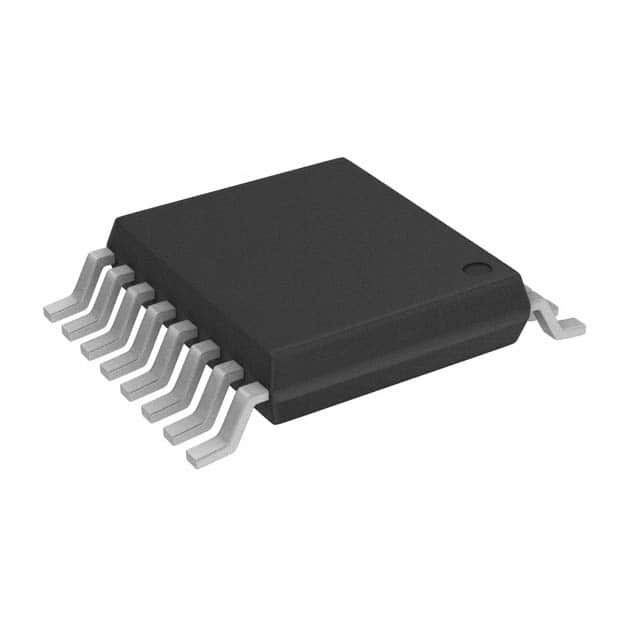Xem thông số kỹ thuật để biết chi tiết sản phẩm.

MM74HC175MTC
Product Overview
- Category: Integrated Circuit (IC)
- Use: Flip-Flop
- Characteristics: High-Speed, Quad D-Type Flip-Flop with Clear
- Package: 16-TSSOP
- Essence: The MM74HC175MTC is a high-speed quad D-type flip-flop with clear. It operates on a wide voltage range and offers improved noise immunity.
- Packaging/Quantity: The MM74HC175MTC is available in a 16-TSSOP package and is typically sold in reels of 2500 units.
Specifications
- Supply Voltage Range: 2V to 6V
- High-Level Input Voltage: 2V
- Low-Level Input Voltage: 0.8V
- Output Current: ±25mA
- Propagation Delay Time: 14ns (typical)
- Operating Temperature Range: -40°C to +85°C
Pin Configuration
The MM74HC175MTC has a total of 16 pins, each serving a specific function:
- CLR (Clear) - Clear input pin
- D0 (Data Input 0) - Data input for flip-flop 0
- CP0 (Clock Pulse 0) - Clock pulse input for flip-flop 0
- Q0 (Flip-Flop 0 Output) - Output of flip-flop 0
- D1 (Data Input 1) - Data input for flip-flop 1
- CP1 (Clock Pulse 1) - Clock pulse input for flip-flop 1
- Q1 (Flip-Flop 1 Output) - Output of flip-flop 1
- GND (Ground) - Ground reference
- Q2 (Flip-Flop 2 Output) - Output of flip-flop 2
- CP2 (Clock Pulse 2) - Clock pulse input for flip-flop 2
- D2 (Data Input 2) - Data input for flip-flop 2
- Q3 (Flip-Flop 3 Output) - Output of flip-flop 3
- CP3 (Clock Pulse 3) - Clock pulse input for flip-flop 3
- D3 (Data Input 3) - Data input for flip-flop 3
- VCC (Supply Voltage) - Positive supply voltage
- CLR (Clear) - Clear input pin
Functional Features
- High-speed operation allows for efficient data processing.
- Quad D-type flip-flop design enables the storage and manipulation of multiple data inputs.
- Clear input functionality allows for resetting the flip-flops to a known state.
- Wide voltage range support enhances versatility in various applications.
- Improved noise immunity ensures reliable operation even in noisy environments.
Advantages and Disadvantages
Advantages: - High-speed operation enables quick data processing. - Quad design provides flexibility in handling multiple data inputs. - Clear input allows for easy reset of flip-flops. - Wide voltage range support enhances compatibility with different systems. - Improved noise immunity ensures reliable performance.
Disadvantages: - Limited number of flip-flops (4) may not be sufficient for complex applications requiring more storage elements. - The 16-TSSOP package may not be suitable for space-constrained designs.
Working Principles
The MM74HC175MTC operates based on the principles of flip-flops. It consists of four individual D-type flip-flops, each capable of storing a single bit of information. The clock pulse inputs (CP0 to CP3) control the timing of data storage, while the data inputs (D0 to D3) determine the information to be stored. The clear input (CLR) allows for resetting the flip-flops to a known state.
Detailed Application Field Plans
The MM74HC175MTC can be utilized in various applications, including but not limited to:
- Digital Data Storage: The quad flip-flop design makes it suitable for storing digital data in microcontrollers, memory systems, and communication devices.
- State Machine Implementation: The flip-flops can be used to implement state machines in digital logic circuits, enabling sequential control and decision-making processes.
- Clock Synchronization: The MM74HC175MTC can be employed to synchronize clock signals in digital systems, ensuring proper timing and coordination between different components.
- Address Decoding: By utilizing the flip-flops as address storage elements, the IC can be used for address decoding in memory systems and peripheral devices.
Detailed and Complete Alternative Models
- SN74HC175N: Similar quad D-type flip-flop with clear, offered in a 16-DIP package.
- CD40175BE: Quad D-type flip-flop with
Liệt kê 10 câu hỏi và câu trả lời thường gặp liên quan đến ứng dụng MM74HC175MTC trong giải pháp kỹ thuật
Sure! Here are 10 common questions and answers related to the application of MM74HC175MTC in technical solutions:
Q: What is MM74HC175MTC? A: MM74HC175MTC is a quad D-type flip-flop integrated circuit (IC) that can store and manipulate digital data.
Q: What are the key features of MM74HC175MTC? A: Some key features of MM74HC175MTC include high-speed operation, wide operating voltage range, low power consumption, and compatibility with TTL inputs.
Q: How can MM74HC175MTC be used in technical solutions? A: MM74HC175MTC can be used for various applications such as data storage, data synchronization, frequency division, and general-purpose logic functions.
Q: What is the maximum operating frequency of MM74HC175MTC? A: The maximum operating frequency of MM74HC175MTC is typically around 50 MHz.
Q: Can MM74HC175MTC handle both positive and negative edge-triggered operations? A: No, MM74HC175MTC is only capable of positive edge-triggered operations.
Q: What is the recommended power supply voltage for MM74HC175MTC? A: The recommended power supply voltage for MM74HC175MTC is usually between 2V and 6V.
Q: Does MM74HC175MTC have any built-in protection features? A: No, MM74HC175MTC does not have any built-in protection features. External measures should be taken to protect the IC from voltage spikes or ESD.
Q: Can MM74HC175MTC drive LEDs directly? A: Yes, MM74HC175MTC can drive LEDs directly as long as the current requirements of the LEDs are within the IC's output capabilities.
Q: Is MM74HC175MTC suitable for battery-powered applications? A: Yes, MM74HC175MTC is suitable for battery-powered applications due to its low power consumption.
Q: Are there any specific precautions to consider when using MM74HC175MTC? A: Some precautions include avoiding excessive voltage or current, ensuring proper decoupling capacitors, and following the recommended operating conditions mentioned in the datasheet.
Please note that these answers are general and may vary depending on the specific application and requirements. It is always recommended to refer to the datasheet and consult with technical experts for accurate information.

